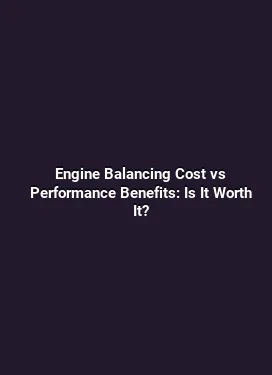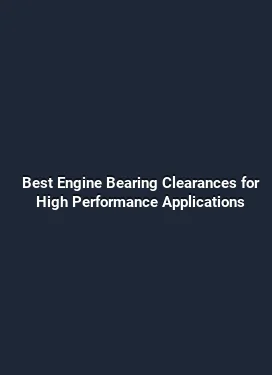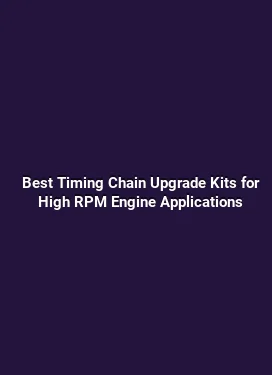How to Choose Right Camshaft Duration and Lift for Street Car
Camshaft specifications drive the heart of an engine’s power and drivability. For a street car, the goal is a balanced package that delivers usable torque at low to mid RPM, smooth idle, and reliable top-end air flow for highway cruising. This guide walks through practical considerations, real-world examples, and step-by-step reasoning to help you select the right camshaft duration and lift for a street-oriented build. The focus is on actionable decisions, backed by engine physics and tuning realities that enthusiasts encounter on public roads and track days alike.
Fundamental Effects of Duration and Lift on Streetable Power

Cam duration is a measure of how long the intake valve stays open during the engine cycle, typically expressed in degrees of crankshaft rotation. Lift describes how far the valve opens at peak. Both parameters influence the engine’s ability to fill and empty the cylinder, which in turn affects torque, horsepower, and throttle response. A longer duration and greater lift usually increase top-end power but can sacrifice low-end torque and idle quality if not matched to the rest of the system.
On a street car, the target is to optimize volumetric efficiency across a usable RPM range. When the cam opens earlier and closes later, the engine can breathe more air at higher RPM. However, if the intake and exhaust systems, cylinder head flow, compression ratio, and fuel delivery aren’t aligned, the vehicle may exhibit rough idle, lumpiness, or poor part-throttle response. A well-chosen camber and lift should harmonize with the intake manifold design, ECU fueling strategy, exhaust backpressure, and the torque curve that suits daily driving and occasional spirited acceleration.
How to Assess Your Baseline: Stock Versus Aftermarket Potential
Before choosing a camshaft, assess the current configuration. Document compression ratio, intake and exhaust flow numbers, ignition timing behavior, fuel system capacity, and current torque curves. If the baseline is a modern, direct-injected or port-injected engine with variable valve timing, the stock hardware often supports a broader range of cams than a simple bolt-in. The key is to identify the RPM range where you want the engine to perform best—daily driving might favor a broad, usable torque band, while a weekend warrior setup might push the peak to higher RPMs with a more aggressive curve.
Consider also the exhaust thresholds. A cam that is too aggressive for a stock exhaust and catalytic system can result in excess backpressure, which reduces the expected gains. Conversely, a less aggressive cam paired with a well-designed exhaust can yield a strong, driveable torque increase without sacrificing street manners. Gather data from your current drive cycle, including accelerator pedal position versus RPM and torque feedback where available, to map the realistic improvement window.
Matching Cam Duration to RPM Band and Vehicle Weight
Vehicle weight and gearing dramatically influence how cam duration translates into real-world performance. A lighter car with short gearing benefits from cams that push power into the mid-range, delivering quick throttle response and strong low-end torque. Heavier vehicles or those with taller gears may require a cam profile that sustains airflow further into the mid-to-high RPM to maintain usable acceleration on highway ramps or hills. A practical approach is to determine the target peak horsepower RPM and design the cam to favor a broad torque spread around that point.
When the engine operates in an urban driving loop with frequent stop-and-go, excessive duration can rob idle quality and throttle response. The goal is to maintain a smooth idle, stable vacuum, and manageable cam phasing across part throttle, mid-range, and WOT (wide-open throttle) conditions. This often means selecting a duration in the moderate range and pairing it with lift that is sufficient to obtain the desired inflow without overtaxing valve train components or fueling systems.
Practical Camshaft Duration Numbers for Typical Street Setups
For naturally aspirated street engines, a common starting point is a duration in the mid-230s to mid-270s at 0.050 inches lift, with a lift in the 0.350–0.420 inch range on a modern cylinder head. This range often yields a broad usable torque curve with acceptable idle and drivability. When adding forced induction, the optimal duration typically shortens in the lower RPM ranges because the blower or turbo effectively increases the manifold pressure; however, lower duration can still yield strong mid-range torque if the intake and exhaust are tuned to match the compression ratio and fueling capacity.
It’s important to note that the actual seat timing—valve opening and closing events at zero lift—depends on the cam’s base circle and lobe separation angle. A tighter lobe separation angle can increase overlap, which tends to improve high-RPM breathing but can reduce idle quality and vacuum at lower RPMs. A wider angle generally smooths idle and improves vacuum, which is often preferred for street use. When comparing options, consider the entire valve train package, including springs, retainers, pushrods, and potential machining requirements on the cylinder heads.
Understanding Lobe Profiles: Ramp Rate, Overlap, and Tone
Camshaft lobes differ not only in duration and lift but in ramp rates and blend between the opening and closing events. A steeper ramp (aggressive ramp rate) allows the valve to reach a higher lift quickly, increasing instantaneous airflow but also imposing higher inertial loads on valve springs and timing components. On a street car, moderate ramp rates help maintain steady idle and reduce spring chatter, while still delivering meaningful airflow gains at the desired RPM range.
Valve overlap—the moment when both intake and exhaust valves are open—is another critical factor. A larger overlap can boost high-RPM performance and exhaust scavenging but tends to degrade low-RPM torque and idle. For daily driving, a balance that minimizes overlap while achieving the target mid-range torque is often preferable. If a cam with significant overlap is chosen, it is common to pair it with a higher compression ratio and improved exhaust scavenging to preserve drivability.
Valvetrain and Component Considerations: Springs, Pushrods, and Geometry
Selecting a camshaft is inseparable from the valvetrain it sits upon. Valve springs must provide adequate seat and open pressures across the RPM range to prevent float or coil bind. A cam with higher lift demands stiffer springs and potentially longer or different geometry to ensure reliable valve motion. Pushrod length and geometry influence the actual lift at the valve, so a cam upgrade might require precise spring and rocker geometry verification or even headwork to preserve phase accuracy and ensure the valve train remains within the material limits.
In modern engines with variable valve timing, cam timing itself can be actuated by the ECU. In such cases, tuning becomes a collaborative process between hardware choices and software strategies. The engine management approach must respect the new flow characteristics introduced by the cam, especially during throttle transitions and deceleration fuel cut or idle control strategies. Ensuring that the intake manifold pressure and fueling are well-matched across the RPM spectrum is essential for a stable, predictable driving experience.
Intake, Exhaust, and Supporting Modifications: Necessary Upgrades
A cam change rarely stands alone. For street applications, a complementary set of modifications often yields the best results. A freer-flowing intake, properly sized throttle body or intake plenum, and a less restrictive exhaust system can unlock the gains offered by the new cam. The goal is to reduce bottlenecks and maintain a smooth, predictable air-fuel balance across RPM ranges. If the exhaust remains restrictive or the intake is poorly matched to the cam profile, the engine may not realize the full potential of the chosen duration and lift.
Fueling strategy is equally important. A cam that shifts the torque peak to higher RPM can require a leaner or richer air-fuel ratio option depending on the engine’s compression and ignition timing. In many street builds, a calibrated fuel map with proper wideband feedback ensures consistent fueling under varying loads and temperatures. This not only improves performance but also protects the engine from misfires, detonation, or lean run conditions that could harm longevity.
Tuning and Data-Driven Decisions: How to Validate Cam Choices
The tuning process should be backed by data. Use wideband oxygen sensors to verify A/F ratios, monitor knock events, and track torque and horsepower curves on a dynamometer or a robust on-road testing plan. A well-planned test sequence includes idle stability checks, part-throttle progressions, and WOT runs at multiple gears and temperatures. The objective is to build a coherent map that demonstrates how the cam’s duration and lift contribute to a usable and repeatable power increase without compromising drivability.
Record the vehicle’s behavior at different temperatures and fuel grades, noting any changes in idle smoothness, throttle response, and acceleration feel. The cam’s effect on power delivery can be subtle or pronounced depending on how well the rest of the system is tuned. In some cases, small adjustments in ignition timing, fueling calibration, or a modest cam upgrade can yield a significant improvement in the real-world driveability of a street car.
Practical Examples: From Stock to Street-Ready
Example A: A modest NA street build with a cam in the mid-240s duration and lift around 0.380 inch. The goal is broad torque with good idle and steady highway performance. Supporting upgrades include a freer-flowing exhaust, an optimized intake, and a calibrated ECU map. The result is a smoother power curve with a noticeable mid-range pull, comfortable cruising, and a satisfying throttle response when exiting highways or climbing grades.
Example B: A turbocharged setup that shifts torque up the RPM ladder. A cam with shorter duration but higher lift can preserve turbo response and prevent lag, while a well-matched exhaust and intercooling system maintain charge temperature stability. Tuning emphasizes ignition timing management and precise fueling to maximize air utilization without detonation under boost. This approach yields strong mid-range torque that scales into high RPM with a controlled, linear feel on the accelerator pedal.
Example C: A lightweight application with aggressive gearing. A cam with moderate duration and lift can deliver rapid throttle response and strong torque at lower speeds, making city driving lively yet manageable. The accompanying tuning strategy focuses on maintaining steady vacuum for idle control and ensuring stable fuel trims across varying engine loads.
Head-to-Head Comparison: Choosing Between Common Cam Styles
The market offers a spectrum of profiles, from mild to wild. A conservative, street-friendly profile prioritizes idle quality and broad torque, with a smooth transition into the power band. A more aggressive profile targets higher RPM power but requires careful balancing with the intake, exhaust, and fueling systems to preserve drivability. When evaluating options, consider the entire package instead of evaluating duration or lift in isolation. The best choice often depends on the vehicle’s weight, gearing, fuel system, and the intended daily usage patterns.
Pay attention to the lobe profile and its impact on valve train dynamics. Some manufacturers offer camshafts designed to work with specific coil springs and retainers, reducing the risk of float at elevated RPM. If selecting a cam from a different vendor, ensure compatibility with the valve springs, pushrods, and cylinder head geometry. Documentation from the manufacturer and community experiences can help anticipate potential valve train issues before installation.
Safety, Reliability, and Longevity Considerations
Increasing intake and exhaust flow puts more stress on the engine’s internals. This means verifying that the lubrication system can maintain proper oil pressure at higher RPM and temperatures. Heat management becomes critical, particularly in hot climates or track days. Regular maintenance and inspection of the valvetrain, timing components, and fuel system should be part of the routine after any cam upgrade.
Detonation risk rises if the fueling map is not aligned with the new cam profile. Advanced timing and fuel management strategies, including appropriate octane ratings and temperature compensation, help ensure reliability. It is wise to perform a controlled, incremental testing plan, documenting the engine’s response to each change, rather than making several large adjustments at once. This approach makes it easier to identify the exact cause of any drivability issues and to refine the tune accordingly.
First Steps for Your Cam Upgrade

1) Define the target RPM range and daily usage profile. 2) Audit the intake, exhaust, and head flow capabilities. 3) Choose a cam profile with duration and lift that match the airflow and cylinder pressure expectations. 4) Verify valve train compatibility with springs and retainers. 5) Plan a staged tuning strategy with robust data collection. 6) Validate performance with controlled tests across temperatures and fuels.
Common Pitfalls to Avoid
Rushing toward a high-lift, long-duration cam without supporting flow and fueling can lead to poor idle and limited throttle response. Inadequate spring pressure can cause valve float, especially at higher RPM. Underestimating the importance of exhaust backpressure or overestimating the ECU’s ability to compensate can mask issues only to reveal them during spirited driving or hot weather conditions. A methodical, data-driven approach reduces the risk of misalignment between cam timing and the engine’s breathing capabilities.
When done correctly, a cam upgrade for a street car yields a more enjoyable driving experience, with linear power delivery, better throttle response, and a torque feel that pulls confidently through the mid-range. The outcome should feel natural in everyday driving while still offering a meaningful improvement under spirited acceleration.






